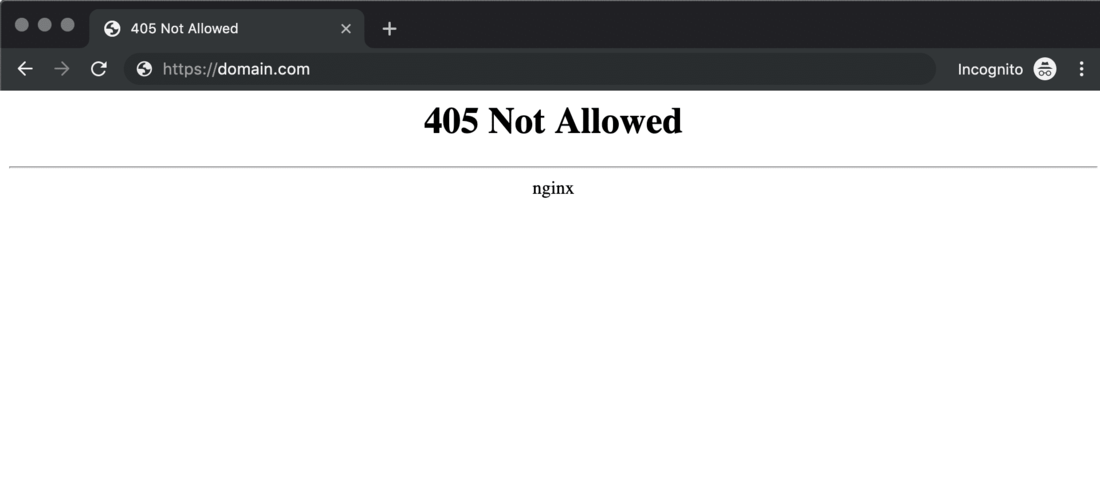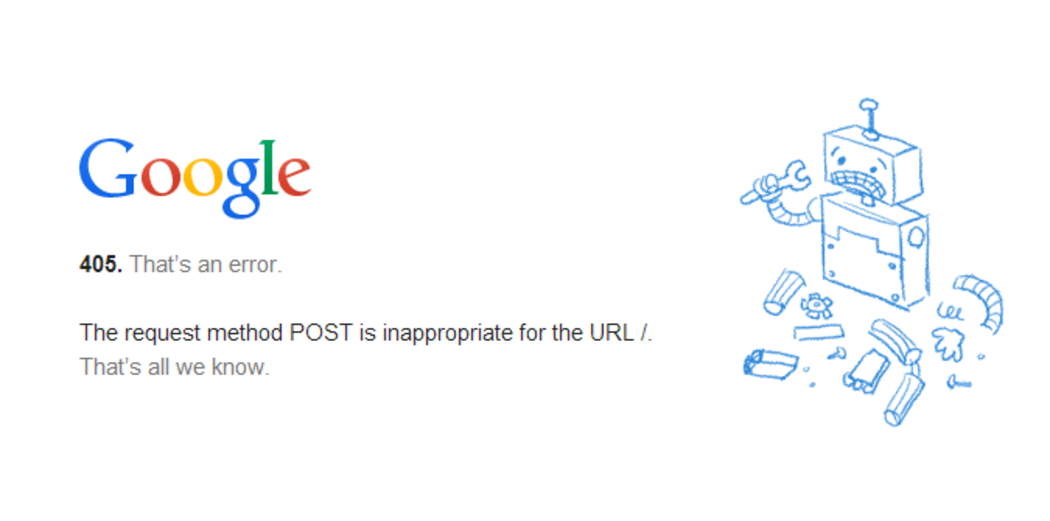How to Fix 405 Method Not Allowed? [Actionable Guide]
Vinh Jacker | 09-05-2023
![How to Fix 405 Method Not Allowed? [Actionable Guide] - Mageplaza](https://cdn2.mageplaza.com/media/blog/405-method-not-allowed/405-method-not-allowed-cover.png)
When someone explores your website, it is a good bet that they will easily get angry or leave if they see an error page. This can lead to a lot of lost business and sales.
One of the most common errors you should pay attention to is an HTTP response status code called “405 Method Not Allowed”. So, how to fix it?
This article will provide detailed step-by-step instructions to help you resolve 405 Method Not Allowed errors yourself. Let’s explore now!
What Is 405 Method Not Allowed Error?
The 405 Method Not Allowed error is an HTTP response status code that indicates the server has received and recognized the request, but the specified HTTP method is not allowed for the requested resource. In other words, the server understands the request, but it cannot fulfill it using the method specified in the request.
The 405 error message may appear in various forms, such as:
- 405 Not Allowed
- Method Not Allowed
- HTTP 405 Error
- HTTP Error 405 – Method Not Allowed
- HTTP 405 Method Not Allowed
No matter how they may seem, the “405 Method Not Allowed” errors can be quite challenging to troubleshoot. They don’t provide any details on the error’s underlying cause. Although they indicate that something has gone wrong, it is typically up to the user to determine the root cause of the issue and attempt to fix it.

The Impact of the Status Code 405 Method Not Allowed
A 405 Method Not Allowed error can have a negative impact on your website in a few ways: User Experience: When users encounter this error, they are met with a message indicating the action they tried is not allowed. This can be confusing and frustrating, especially if they don’t understand why they can’t do what they were trying to do. This can lead to users abandoning your site and going to a competitor’s.
- Search Engine Optimization (SEO): Search engines may not crawl and index your pages properly if they encounter frequent 405 errors. This can hurt your website’s ranking in search results.
- Functionality: Depending on the cause of the error, critical features of your website may not work correctly. This could include things like logging in, submitting forms or adding items to a shopping cart.
What Causes The Status Code 405 Method Not Allowed?
The server turned into a 405 Method Not Allowed when a client attempts to use an HTTP method that is not allowed or supported for the requested resource. For better understanding, the followings are the examples you can refer to:
-
The requested resource does not allow the HTTP method: This method specified in the request has been recognized by the server; however, it is not allowed to be used on the requested resource. For instance, if a client tries to use a method like PUT or DELETE on a resource that only permits the GET or POST requests, the server will respond with a status code 405 Method Not Allowed error.
-
Misconfigured server: Unconfigured settings for some HTTP methods limited to specific resources may be present on the server. This could result from a human error, improper server configuration, or security measures in place.
-
REST API interactions: In the context of REST APIs, the 405 error is a common response encountered when working with REST APIs, indicating that the requested method is not allowed for the given resource.
-
Search engine indexing: URLs with a 405 Method Not Allowed response status will not be indexed by search engines like Google, leading to their removal from search results.
-
Developer mistakes: Developers working on web applications or APIs may encounter the 405 Method Not Allowed error if they mistakenly send a request to the wrong endpoint or use an unsupported method for a specific resource.
-
Server-side limitations: For security or policy reasons, some servers have restrictions in place that limit or block certain HTTP methods. There are a few possible causes, such as server configuration, security policies, and framework & middleware limitations.
Note that: Depending on how a client interacts with the server, application, or APIs, the exact cause of the status code 405 Method Not Allowed may differ. In a specific context, you can gain additional insight into the cause of an error by examining server log files or looking for documentation and support resources supplied by your server or application.

Closely related errors include 404 Not Found Laravel and 406 Not Acceptable
How To Fix The HTTP 405 Method Not Allowed: 9 Ways To Follow
Given that the 405 Method Not Allowed response code is considered a client-side error, it is best to begin troubleshooting any issues arising from client interactions. However, there is a fact that the web browser or device being used for accessing the application is referred to as ‘client.’
Thus, in addition to checking client-side elements, you can typically focus on the server-side code, server configurations, and backend components. The logic and functionality of the server that handles data processing, business rules, and communication with databases or other external systems shall be covered.
Following are some recommendations you can try on the browser or device giving you the problems to successfully resolve them.
1. Use Appropriate URLs
Incorrect URLs can sometimes trigger the “405 Method Not Allowed” error. If you input the wrong URL, the browser will result in a page that does not exist.
There are some common cases, such as: using a missing letter or misspelled word in the URL. Generally, many web servers will disallow access to improper URLs. Note that: Double-check that your URL is correct and points to the intended resource.

2. Verify The HTTP Method
As mentioned above, the HTTP response status codes in the 4xx category are often considered client error responses. Thus, double-check the HTTP method you use to access the resource.
Standard methods include GET, POST, PUT, DELETE, etc. The chosen method should match the allowed ones for the requested resource. For instance, if the resource only allows GET requests, ensure you’re not using a POST or PUT method.
3. Verify Resource Permissions
Before attempting to access a resource, verify its permissions. The server may fail to accept some HTTP methods when the permissions are set incorrectly. In order to prevent the 405 Method Not Allowed error resulting from developer mistakes, review of and correction of code are essential.
The developers should thoroughly check their code and verify whether or not they’re targeting the correct endpoints to ensure that each HTTP request is supported by the right HTTP method.
For this purpose, you should inspect the API documentation, and server specifications or communicate with administrators so that your code aligns with the expected behavior of the server. Ensure that the resource will allow you to use your method.
4. Review API Documentation
If you are working with an API , consult the API documentation to ensure you use a valid HTTP approach for your specific endpoint.
For various resources, APIs often contain guidelines or limitations on supported methods. Note that: You have to adhere to the documented requirements.
5. Check The Server-side Logs
Every web application will store the majority form of server-side logs. Application logs are the history of the app’s actions, such as pages requested, installed servers, database results, etc.
The server logs are associated with the hardware used to run this application. Detailed information on the health and status of any connected service or server itself is provided in logs.
6. Check The Server Configuration
Specific restrictions or configuration settings may be introduced on your server to prevent some HTTP methods from being used for this resource. Check server configuration files like the .htaccess file for Apache servers to ensure the HTTP method you want is allowed.
7. Consider Web Framework or Content Management Systems Requirements
Generally, a particular web framework or Content Management System (or CMS) may have specific requirements or configurations related to HTTP methods.
To find out if there are any specific considerations to address the 405 Method Not Allowed error, it is best to check the framework’s documentation or the community forums.
Besides, you better run into cross-origin resource sharing (CORS) limitations when you submit requests from different domains or ports than the server. Make sure that the server’s configuration allows cross-origin requests if needed.
8. Revert Updates or Uninstall Extensions, Theme, or Plugins
The code for your website can be modified when you install a theme, plugin, or extension. Updates to any of these elements may cause server-side changes that may cause any issues.
Try to restore all the recent updates you have done on your website, platform, extensions, themes, modules, or plugins. Or, you can try uninstalling and reinstalling this again if the error message appears.
Caution: these extensions may control the system at all times and will make virtually any changes. This is why, in case you suddenly experience the HTTP 405 Method Not Allowed error, it may be wise to uninstall any new extensions.
9. Try Other HTTP Methods or Contact To The Support Team
In case all else fails, and it is still impossible to resolve the issue, try another browser, or use other HTTP methods if available. Besides, if you are approaching a third-party service or API, contact their support team for any support. According to their system, they may provide you with specific guidance.

Conclusion
Overall, in order to resolve the 405 Method Not Allowed status code, you can use one or more of the nine methods we suggest above. By doing so, you can continue browsing the web without any interruptions.






![Top 20+ Must-have Shopify Apps for 2025 [Free & Paid] - Mageplaza](https://cdn2.mageplaza.com/media/blog/must-have-shopify-apps/top-must-have-shopify-apps.png)
![[2025 Updates] Top 10+ Upsell Apps for Shopify - Mageplaza](https://cdn2.mageplaza.com/media/blog/best-upsell-shopify-app/cover.png)